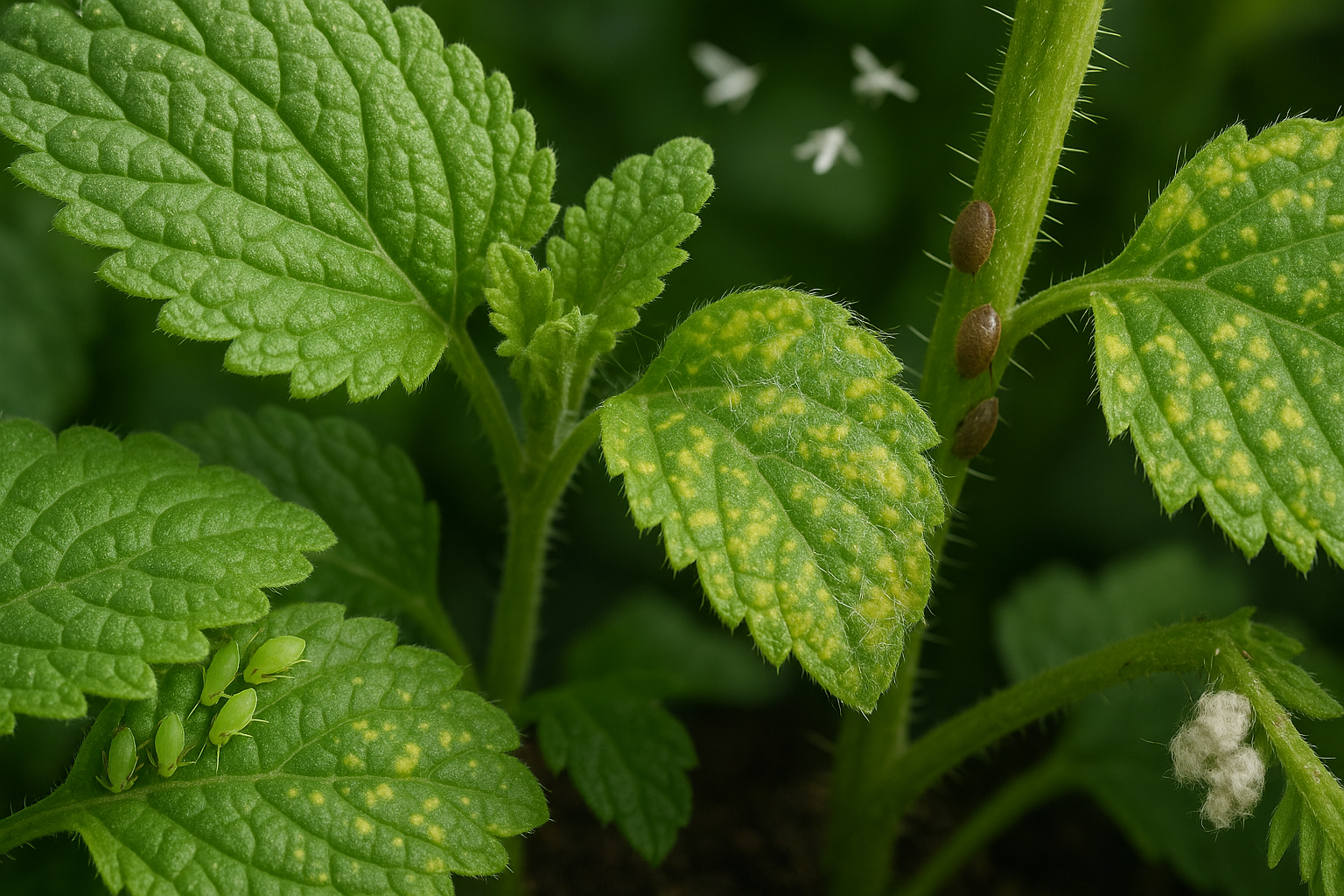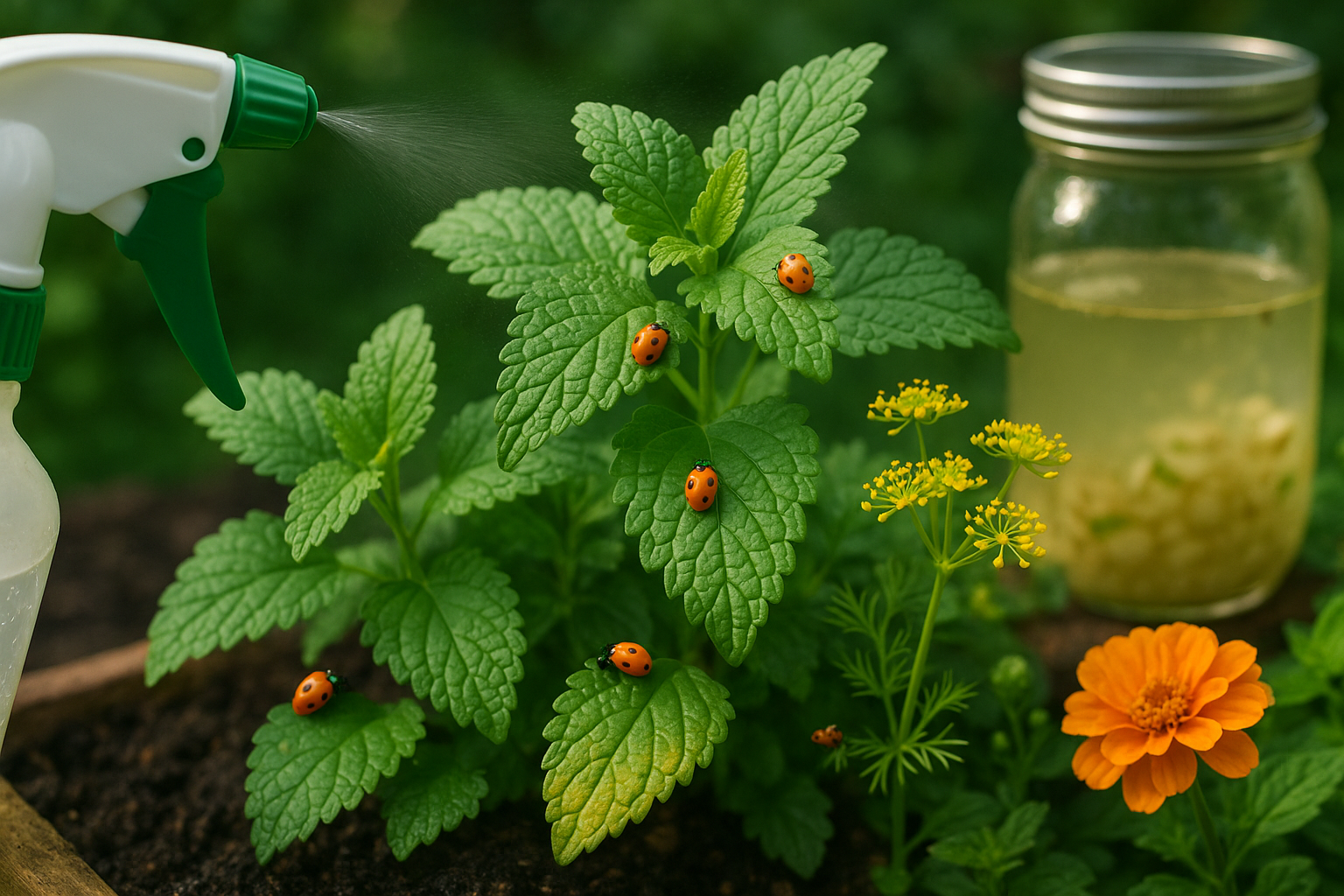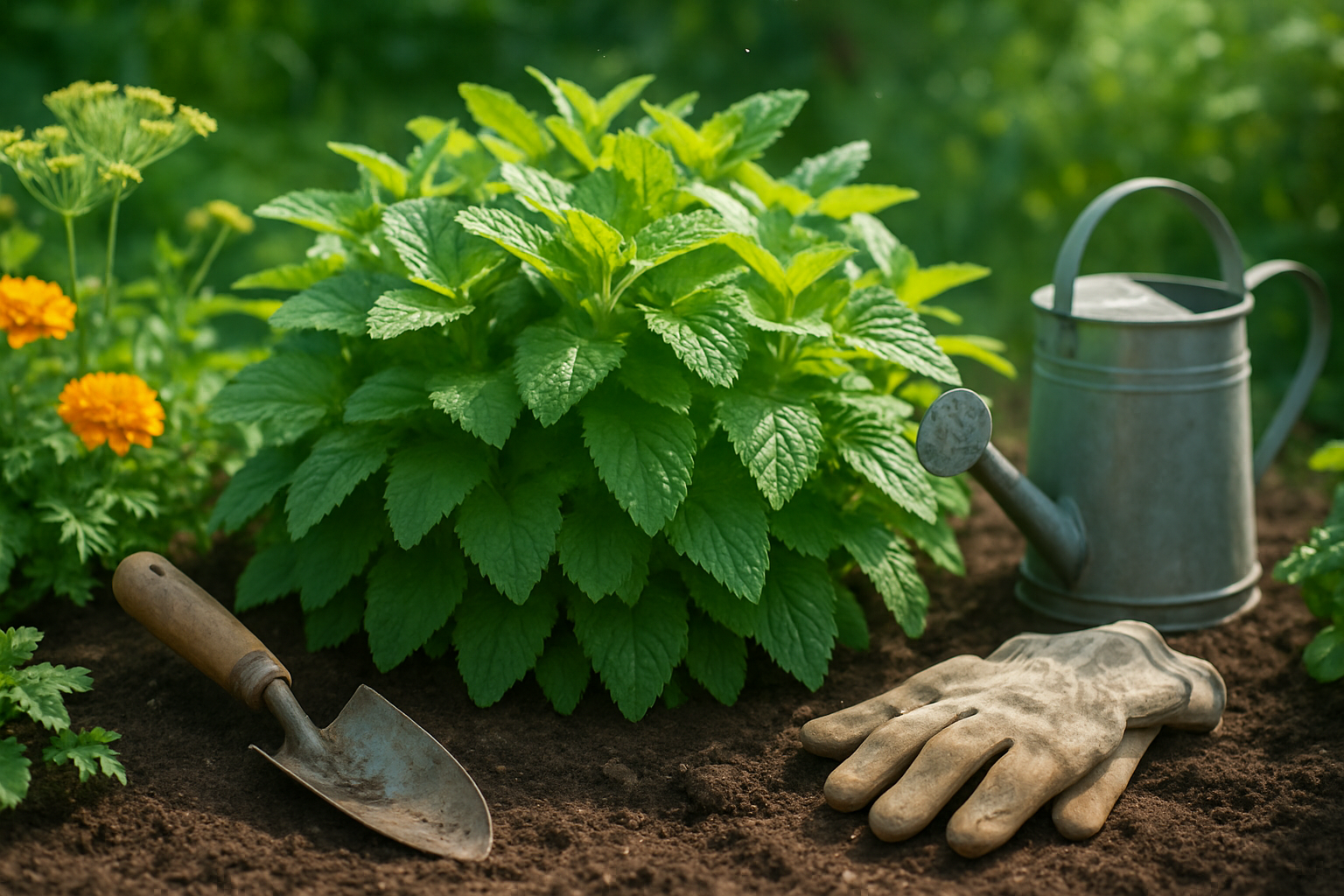Introduction
Lemon balm is a beloved staple in many gardens, prized for its soothing scent and versatility in teas and recipes. While this hardy herb is known for being resilient and low-maintenance, lemon balm pests can still threaten its lush, healthy growth. Even the most robust lemon balm patch isn’t immune to nibbling insects and other critters that may compromise your harvest.
Fortunately, you don’t need to reach for harsh chemicals to protect your plants. In this article, you’ll discover how to identify the most common lemon balm pests, from aphids to spider mites, and learn natural, eco-friendly techniques to keep your lemon balm thriving—using strategies like homemade sprays, companion planting, and simple garden maintenance. Whether you’re a beginner or a seasoned gardener, these tips will help you protect your lemon balm and enjoy a flourishing herb garden all season long.
Common Lemon Balm Pests and How to Spot Them

Lemon balm, while a resilient and aromatic herb, can sometimes attract a handful of common pests, each leaving its own telltale signs.
Aphids are among the most prevalent—tiny, pear-shaped insects that cluster under leaves and at growing tips. They often cause yellowing and distorted foliage alongside a sticky residue called honeydew.
Spider mites are even smaller and harder to spot, but they leave behind fine webbing and stippled, yellow-speckled leaves.
Whiteflies are minute, white, moth-like bugs that flutter up in clouds when the plant is disturbed. Their feeding leads to wilting and sticky deposits, encouraging sooty mold growth.
Scale insects look like small, brown bumps attached firmly to stems and undersides of leaves. They suck sap, leaving plants weakened and yellow.
Mealybugs present as cottony, white masses on stems and leaf axils. They also secrete honeydew, resulting in curled, stressed leaves.
Fungus gnats, although more of a nuisance for young plants and seedlings, are tiny, black flies hovering around moist soil. Their larvae can damage roots, leading to wilting and poor growth.
To catch these pests early, inspect your lemon balm at least once a week. Turn leaves over and check stems closely, using a magnifying glass for hard-to-see bugs like spider mites. Be alert for any changes in leaf color, sticky or shiny patches, visible bugs, webbing, or odd growth patterns. A gentle shake of the plant can help flush out flying pests like whiteflies.
Early detection is the best defense—removing or treating small infestations promptly can keep your lemon balm healthy and pest-free. Make routine checks part of your gardening habit.
Natural Control Methods for Aphids and Whiteflies

Dealing with aphids and whiteflies in your garden doesn’t have to mean reaching for harsh chemicals. Start with simple manual removal—if you spot these tiny pests, use a strong blast of water from a hose to dislodge them from leaves and stems. For more stubborn infestations, gently wipe the leaves with a damp cloth or a soft brush, which works especially well for delicate plants you don’t want to damage.
Beyond physical methods, you can let nature lend a hand: beneficial insects like ladybugs and lacewings are voracious predators of both aphids and whiteflies. You can buy them online or at garden centers and release them onto problem plants. To attract more of these helpers naturally, plant flowers such as dill, fennel, or marigolds nearby. These companion plants draw in beneficial bugs while deterring common pests.
If you need an added layer of defense, try organic sprays. Neem oil not only disrupts insect feeding and reproduction but is also safe for most plants when used as directed. Insecticidal soap works by breaking down the pests’ outer shells, making it very effective against both aphids and whiteflies; just be sure to spray the undersides of leaves where these pests like to hide. For a DIY option, make a garlic-based spray by blending several garlic cloves with water, straining, and misting it onto affected areas—garlic’s pungent smell repels many soft-bodied insects.
By combining these methods, you’ll tackle infestations while keeping your garden eco-friendly and safe for pollinators.
Managing Spider Mites and Mealybugs Naturally
Spider mites and mealybugs thrive on lemon balm because the plant’s soft, aromatic leaves provide an ideal food source and habitat, especially in warm, dry environments. You’ll know you have a problem if you spot tiny webs, yellow stippling, or faded patches on leaves—classic signs of spider mites—or find clusters of white, cottony masses along stems indicating mealybug colonies.
Both pests suck plant sap, causing stunted growth and, if left unchecked, can eventually kill the plant. To discourage infestations, boost humidity around your lemon balm by misting the leaves regularly or clustering plants together—these pests favor dry air, so moisture makes life harder for them.
A strong rinse with plain water can also dislodge pests, especially when done early and frequently. For stubborn infestations, try a gentle spray of neem oil or horticultural oil, both safe and effective for edible plants when used as directed.
Natural pest control is also possible by inviting beneficial insects like ladybugs, lacewings, and predatory mites. These allies feed on spider mites and mealybugs, helping keep populations in check. To attract them, plant nectar-rich flowers such as alyssum, dill, or yarrow nearby, and avoid using broad-spectrum insecticides that could harm your garden’s helpful bugs.
With a bit of regular care and attention, you can keep your lemon balm healthy and pest-free without resorting to harsh chemicals.
Dealing with Scale Insects and Fungus Gnats
When battling scale insects and fungus gnats, it’s important to first know your enemy. Soft scale insects are small, rounded pests that excrete sticky honeydew, often leaving plants with sooty mold and a glossy residue. In contrast, armored scale insects have a tougher, protective shell and don’t produce honeydew, making them trickier to spot since there’s less mess but more direct damage to the plant as they suck sap.
Both types of scales can be removed manually with a cotton swab dipped in rubbing alcohol—focus on the stems and leaf undersides, checking crevices carefully.
For fungus gnats, the main harm isn’t from the adult flies buzzing around; it’s their larvae that chew through tender roots, causing stunted growth or even plant death in severe cases. Using yellow sticky traps near the soil grabs adult gnats before they lay more eggs and gives a quick sense of your infestation size.
To target larvae, let the soil surface dry between waterings since gnats thrive in damp soil. You can also sprinkle cinnamon powder atop the soil as a natural antifungal that disrupts larvae development.
Combine these tips for quick relief:
- Carefully remove visible scales.
- Use sticky traps to catch gnats.
- Always check soil moisture before watering.
This three-pronged approach cuts off pests from all sides and helps restore plant health.
General Organic Pest Management Strategies
One of the best approaches to organic pest control is prevention, and it starts with maintaining healthy soil. Vibrant, nutrient-rich soil supports strong plants that can naturally resist many pests and diseases. You can achieve this by regularly adding compost, incorporating organic matter, and testing your soil every season to keep the pH balanced.
Proper watering is just as crucial—watering early in the day and at the base of plants reduces excess moisture on leaves, which often attracts harmful insects and encourages mold. Spacing your plants correctly is another simple, smart strategy. Overcrowding creates a humid environment where pests thrive, so leave ample room for air to circulate around each plant.
Keeping your garden tidy makes a huge difference, too. Remove dead leaves, spent blooms, and plant debris regularly—these can harbor insects and fungus, acting like pest motels. Pruning also helps by encouraging healthy growth and eliminating weak areas where pests love to hide; prune away diseased or crowded branches as soon as you spot them.
Beyond these habits, consider rotating your crops each year to prevent pest populations from establishing themselves—switch locations for common targets like tomatoes or brassicas. Simple physical barriers like row covers or mesh netting are very effective, especially for keeping out caterpillars, beetles, and aphids without any chemicals.
If you do spot pests, try making your own non-toxic sprays—for example, a mix of water, mild soap, and a splash of oil can deter aphids, while garlic or chili pepper sprays are great for repelling many insects. Always test these sprays on a few leaves first to avoid damaging your plants.
By combining these straightforward strategies, you can enjoy a healthier, happier garden with fewer pest headaches—all without resorting to harsh chemicals.
Maintaining Healthy Lemon Balm
Keeping your lemon balm healthy over the long term is all about meeting its basic needs and staying vigilant. For optimal growth, plant lemon balm in a spot that gets plenty of sunlight—at least six hours a day is ideal, though it can tolerate partial shade if needed. Well-drained soil rich in organic matter helps prevent soggy roots, so consider adding compost or aged manure before planting.
When it comes to watering, aim to keep the soil consistently moist but never waterlogged; a good rule of thumb is to water when the top inch of soil feels dry.
Companion Planting and Pest Control
Companion planting is an excellent strategy for natural pest resistance. Lemon balm thrives alongside crops like tomatoes, cabbage, and broccoli, and its aromatic leaves help deter pests such as mosquitoes and aphids from your other plants.
Remember to check your lemon balm regularly for any signs of pests, like tiny holes in leaves or sticky residue. If you spot trouble early, you can often treat small infestations by manually removing pests or using a gentle, natural spray like diluted neem oil.
Staying proactive with care and monitoring means your lemon balm will remain vibrant, flavorful, and pest-free for many seasons to come.
Conclusion
Choosing natural, sustainable pest management for your lemon balm not only protects your plants but also supports a healthier, more balanced garden environment. Staying vigilant for early signs of pests and sticking to organic methods—like handpicking pests and using homemade sprays—can keep your herbs thriving without harmful chemicals.
Your experiences and questions are valuable, so please share them in the comments below. By learning from each other, we can all grow stronger, more resilient lemon balm and garden ecosystems together. Let’s keep our herbs healthy and support each other in our gardening journeys!
